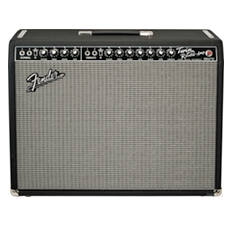 If you need a loud, clean amplifier that can cover venues from church services to packed clubs, you might need to look no further than the Fender ’65 Twin Reverb reissue.
If you need a loud, clean amplifier that can cover venues from church services to packed clubs, you might need to look no further than the Fender ’65 Twin Reverb reissue.
The Fender Twin Reverb has rightly earned its status as a “classic” in the world of guitar gear. Everyone from Eric Johnson to Ted Nugent has used the heralded Twin at one time or another. When it comes to loud, clean tones, few guitar amps have the reputation for delivering such sounds as does the Fender Twin. The amp has had several incarnations over the years – some good, some not. The current incarnation is a reissue of the ’65 Twin Reverb, which leads to the natural question – how does it compare? Can a reissue amplifier – made with modern PCB techniques instead of hand wiring – capture the spirit of the original? Or is it just a Twin Reverb in name only? Read on and see.
Specifications
The Twin Reverb is an 85W all tube amplifier powered by four 6L6 power amp tubes, four 12AX7 preamp tubes, and two 12AT7 tubes (for the reverb and vibrato). Two 12″ Jensen C-12K speakers are standard. The amplifier is dual channel, normal and vibrato, and features classic Fender reverb and vibrato, tilt-back legs, and instantly recognizable black vinyl covering and silver grille cloth.
The normal channel features controls for volume, treble, middle, and bass as well as a bright on/off switch. The vibrato channel sports controls for volume, treble, middle, bass, reverb, speed, and intensity as well as a bright on/off switch. The amp includes a 2-button footswitch to control the reverb and vibrato and weights 64 lbs.
Performance
I tested the Twin with a trio of guitars, a reissue ’54 Fender Telecaster, a reissue ’62 Fender Stratocaster, and a newer Gibson ES-335. Because of its renowned clean sounds, I also used no fewer than a dozen overdrive and distortion pedals to see how well the amp would respond.
As a dual channel amp, I tried out both the normal and vibrato channels and didn’t find much of a tonal difference between the two aside from the fact that the normal channel doesn’t use the reverb or vibrato effects. Also, it’s worth noting that Fender’s “vibrato” is actually a tremolo effect, offering a rise and fall in volume, not pitch (interestingly enough, Fender also erroneously calls a vibrato bridge a tremolo, which is also incorrect). So, my comments can apply equally to both channels.
If you want the loudest clean sound you can find, chances are you’ll find it with the Fender Twin Reverb. In some ways, it might be the ultimate pedalboard amplifier. The clean sound on its own is amazing. The tone controls are very responsive and the reverb/vibrato definitely capture the vintage vibe. Because of its headroom and variety of equalization, you can tailor the sound for any of your overdrive and distortion effects, and it responds very well. As you’d expect, it’s easy to get blues, country, rock, and jazz tones out of this beast. Believe it or not, though, with the right pedal combination, you can even shred with the Fender Twin.
It’s because this is one unbelievably loud amplifier. The headroom on this beast is just incredible. I’ve played them in medium sized clubs before without turning the volume past three. There’s really no venue that they couldn’t cover. Of course, this power comes at a price. If there’s any downside to the ’65 Fender Twin, it’s that this amplifier is freakin’ heavy! At 64lbs, this isn’t an amp that you transport lightly. I strongly suggest that you have either (1) a roadie or (2) a hand truck or (3) incredibly strong knees & back at your disposal. Seriously. Or pain might be in your immediate future.
If you’re wondering whether the reissue can hold its own with an original, I have the answer for you, and it’s a definite “yes.” I used to play in a band with another guitarist who used an original ’65 Twin Reverb. His tone was fantastic, until the amp died one gig never to return to life. He purchased a reissue Twin, and it was just not possible to tell any significant differences between the two. If anything, the reissue was more consistent than his previous amp, which he eventually fixed up and decided to leave at home. The reissue Twin never missed a beat in the dozens of gigs I played with that band. When it was time to pack up for the night, though, he was on his own.
Final Thoughts
The clean volume of the amp gives the Fender Twin a nearly unparalleled degree of pedal-friendly versatility. If power amp distortion is your thing, you might need to look at the lower wattage Deluxe Reverb. But if you need a loud, clean amplifier that can cover venues from church services to packed clubs, you might need to look no further than the Fender ’65 Twin Reverb reissue.
Name of Gear: Fender Twin Reverb Vintage Reissue
List Price: $1,949.99
Manufacturer Info: Fender Musical Instruments; fender.com
Pros: Powerfully loud clean tone
Cons: Heavy